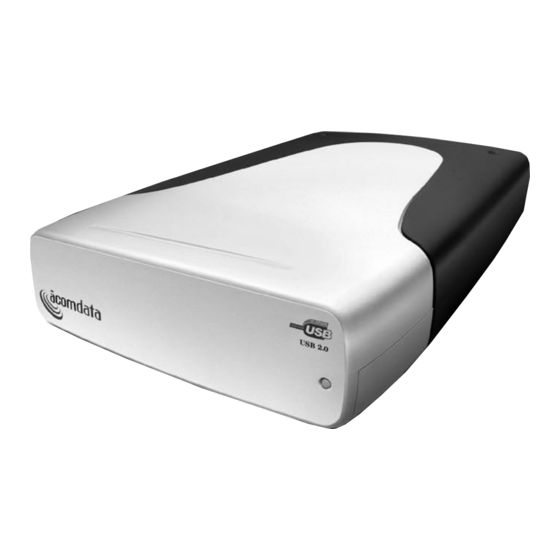
Acomdata External Hard Drive USB 2.0 User Manual
Hide thumbs
Also See for External Hard Drive USB 2.0:
- User manual (109 pages) ,
- User manual (86 pages)
Summary of Contents for Acomdata External Hard Drive USB 2.0
- Page 1 User’s Guide For the AcomData USB 2.0 External Hard Drive Windows & Mac Please retain this guide for future reference.
-
Page 2: Table Of Contents
Parts & Accessories List.......... 5 System Requirements ..........6 About USB 2.0............7 AcomData External Hard Drive at a Glance....8 Technical Specifications ..........9 Connecting the Drive to Your Computer....10 Installing the USB 2.0 CD (Windows 98SE/ME) ..11 Formatting Your AcomData External Hard Drive .. -
Page 3: Welcome
ARRANTY OVERAGE Technical Support: techsupport@acomdata.com Please take a few moments to register your AcomData product. Registration is required in the event that your Pre-Sales Questions: product needs warranty service. Also, please retain your sales@acomdata.com product’s sales receipt; a copy of the sales receipt is also required to attain warranty service. -
Page 4: Precautions
• Do not disconnect any cables with the device powered on. • AcomData highly recommends that you regularly back-up the files stored on your hard drive(s). AcomData is not responsible for any data loss, nor will AcomData perform any recovery of lost data or files. -
Page 5: System Requirements
USB 2.0 YSTEM EQUIREMENTS BOUT USB (Universal Serial Bus) is an interface technology for System Requirement for PC the serial transmission of digital data. The original standard • 233 MHz Pentium or equivalent processor, or faster (USB 1) could transmit data at speeds of up to 12 Mbps. •... - Page 6 Stackable Case Weight (g/kg) ............1190/1.19 If you need more storage, Chassis (approved/recognized)........FCC/CE/UL you can install additional AcomData External Hard Environmental characteristics (operating) Ambient temperature ..........5ºC – 55ºC Drives without taking up more Relative humidity (non-condensing) ......... 8% – 90% desktop space. The case is Maximum wet bulb (non-condensing) ........
-
Page 7: Connecting The Drive To Your Computer
ONNECTING THE the Drive. RIVE TO 4. Press the power switch located on the back of the AcomData A comData OMPUTER Drive. Once the Drive is powered up, your computer should External... -
Page 8: Formatting The Drive In Windows 98Se/Me
RIVE 1. Double-click on the My Computer icon. In the My It is not necessary to format your AcomData External Hard Computer window you should see an icon and drive letter Drive. It was formatted at the factory with the FAT 32 file for the External Hard Drive. -
Page 9: Formatting The Drive In Windows 2000/Xp
If you plan to use the Drive on Mac only, select Mac OS your External Hard Drive is ready to use. Extended. If you also need the Drive to be PC compatible, see the section titled “Formatting Your AcomData External Hard Drive” for more information. Formatting the Drive 5. -
Page 10: How To Safely Dismount And Turn Off Your
4. Click OK. The Drive will dismount and you can then safely OW TO AFELY ISMOUNT turn if off. You may then unplug the power cord and USB FF THE 2.0 cable if you want to disconnect the drive. XTERNAL RIVE Mac Users What do 'mounting' and 'dismounting' mean? When a... -
Page 11: Using Your Drive
SING RIVE AINTAINING RIVE Defragmenting and Optimizing a Hard Drive A hard drive stores data on disks called platters. Each plat- Opening files and folders on your Drive ter surface is divided into concentric tracks, and each track (All Users) is divided into sections called sectors. -
Page 12: Troubleshooting / Frequently Asked Questions (Faq)
There are several software packages available that offer a ROUBLESHOOTING suite of disk management utilities, including defragmenta- tion, optimization, repair, erased file recovery and more. REQUENTLY SKED UESTIONS How often you should perform maintenance operations (FAQ depends on how much you use the drive. Generally speak- ing, you should defrag and optimize a drive once every two FAQs for All Users: or three months, while it’s a good idea to examine a disk for... - Page 13 Look for the Disk that has a capacity closest A: Windows 2000 and XP users will get this alert mes- to your AcomData External Hard Drive. Right-click on the sage if you plugged the Drive into a USB port that only sup- right-hand box;...
-
Page 14: Solving Technical Problems
ECHNICAL ROBLEMS Q: My computer does not recognize the Drive. If you experience a problem with your AcomData product, A: First, check to make sure that all of your connections you should take the following actions in the order specified: are secure. -
Page 15: Glossary
In binary code, a bit is Mbps (Megabits per second) represented logically as a either 1. LABOR: For a period of one (1) year from the original date of purchase from AcomData - A data transmission speed a 1 or a 0. -
Page 16: Notices
OTICES OPYRIGHTS Copyright © 2004 AcomData. All rights reserved. No part of this publication may be reproduced stored in a retrieval system, or transmitted in any form or by any means, electronic, mechanical photocopying, recording or otherwise, without the prior written consent of AcomData. - Page 17 THER INNOVATIVE PRODUCTS DESIGNED TO EMPOWER INSPIRE AND ENTERTAIN RocketPod™ Hi-Performance Peripherals: Revolutionary line of portable, modular peripherals––including DrivePod, DVDPod, NASPod, and more––that stack without wires. Flash Card Readers: Hi-Speed USB 2.0 multi-card readers and single-card read- ers for fast, convenient transfer of digital media files to and from your PC or Mac.













Need help?
Do you have a question about the External Hard Drive USB 2.0 and is the answer not in the manual?
Questions and answers